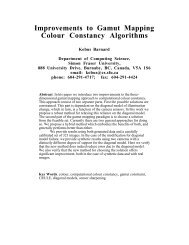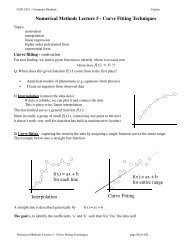1 Introduction
1 Introduction
1 Introduction
- No tags were found...
Create successful ePaper yourself
Turn your PDF publications into a flip-book with our unique Google optimized e-Paper software.
1.2. Probability Theory 17Suppose instead we are told that a piece of fruit has been selected and it is anorange, and we would like to know which box it came from. This requires thatwe evaluate the probability distribution over boxes conditioned on the identity ofthe fruit, whereas the probabilities in (1.16)–(1.19) give the probability distributionover the fruit conditioned on the identity of the box. We can solve the problem ofreversing the conditional probability by using Bayes’ theorem to givep(B = r|F = o) =p(F = o|B = r)p(B = r)p(F = o)= 3 4 × 4 10 × 20 9 = 2 3 . (1.23)From the sum rule, it then follows that p(B = b|F = o) =1− 2/3 =1/3.We can provide an important interpretation of Bayes’ theorem as follows. Ifwe had been asked which box had been chosen before being told the identity ofthe selected item of fruit, then the most complete information we have available isprovided by the probability p(B). We call this the prior probability because it is theprobability available before we observe the identity of the fruit. Once we are told thatthe fruit is an orange, we can then use Bayes’ theorem to compute the probabilityp(B|F ), which we shall call the posterior probability because it is the probabilityobtained after we have observed F . Note that in this example, the prior probabilityof selecting the red box was 4/10, so that we were more likely to select the blue boxthan the red one. However, once we have observed that the piece of selected fruit isan orange, we find that the posterior probability of the red box is now 2/3, so thatit is now more likely that the box we selected was in fact the red one. This resultaccords with our intuition, as the proportion of oranges is much higher in the red boxthan it is in the blue box, and so the observation that the fruit was an orange providessignificant evidence favouring the red box. In fact, the evidence is sufficiently strongthat it outweighs the prior and makes it more likely that the red box was chosenrather than the blue one.Finally, we note that if the joint distribution of two variables factorizes into theproduct of the marginals, so that p(X, Y )=p(X)p(Y ), then X and Y are said tobe independent. From the product rule, we see that p(Y |X) =p(Y ), and so theconditional distribution of Y given X is indeed independent of the value of X. Forinstance, in our boxes of fruit example, if each box contained the same fraction ofapples and oranges, then p(F |B) =P (F ), so that the probability of selecting, say,an apple is independent of which box is chosen.1.2.1 Probability densitiesAs well as considering probabilities defined over discrete sets of events, wealso wish to consider probabilities with respect to continuous variables. We shalllimit ourselves to a relatively informal discussion. If the probability of a real-valuedvariable x falling in the interval (x, x + δx) is given by p(x)δx for δx → 0, thenp(x) is called the probability density over x. This is illustrated in Figure 1.12. Theprobability that x will lie in an interval (a, b) is then given byp(x ∈ (a, b)) =∫ bap(x)dx. (1.24)





